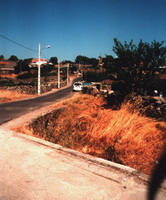 |
 |
 |
Touring the Peninsula With MattFuentes de Onoro
Book
Hotels in Spain
This, a tiny village supposedly in the middle-of-nowhere was once the site of a battle that Wellington described as being a "near run thing." He described the battle as this because of the knife-edge that defeat or victory lay on and the nearness to defeat that the British force came to. As we drove down the short ridge (which, I must admit, was a lot smaller space than I imagined) I could imagine column upon column of French infantry advancing steadily up the ridge, assailed by both the fire of the British infantry, the burning heat of the Spanish sun, and the heavy burden of muskets, packs, and sweat-sodden clothing.
Unfortunately I don't think that we saw the entire stretch of the battlefield, however where we were it was clear to see the bullet marks on the wall of the church that marks the high tide mark of the French advance. Here, a tight-fought battle was taking place, with the two sides literally within centimetres of each other, hidden behind gravestones and balustrades. This battle was so closely fought, with both sides veering close to victory and defeat, but finally Wellington gained a victory, even though he himself did not believe that it was a victory - and did not count it as one.
The battle itself raged for 3 days, with numerous scraps between British and French infantry. On the first day (May 3rd) Massena sent a force of 14 Battalions to attack the village frontally. The battle was grinding and hard on the British and French troops, with the French pushing into the heart of the village several times, but being repulsed at equal length. Finally the French force retreated over the east bank of the stream, having suffered 650 casualties, twice as many as the British. The following day was quiet, with Massena sending scouts to make a reconnaissance of the ridge. This precaution was one that he had seemingly forgotten to take the previous day. This may have been quite a crucial mistake on the basis of how easy it was for the battle to swing to anyone's favour, and with more recon Massena may well have won the day. That afternoon Wellington saw a large force of French troops moving to their left, so as to move round his flank and attack the south of the ridge. Wellington had expected this move but he made the mistake of being too eager to check the advance far away. He stationed the 7th Division and a British cavalry troop at Poco Vela, north of Nave de Haver where a Spanish cavalry force was positioned, hoping to check the French advance. However, on the 5th May, the French cavalry swung wide of Poco Vela and chased the Spanish from Nave de Haver, whilst the cavalry of the Guard attacked the 7th Division. This attack was more than the British could hope to withstand, and more than 4000 French cavalry hounded them as they retreated. Wellington suddenly realised he had committed a terrible mistake by stretching his flank too far, and had to bail out the whole of the 7th division by sending the Light Division to cover their retreat. Massena renewed the attack on the village and the British came worryingly close to defeat, however, they finally repulsed the French, leaving the street reeking of blood and sweat, piled high with British and French corpses. Massena could not keep up the attack, he now only had four rounds of ammunition per man, and he reluctantly stopped attacking. Both generals were displeased with the battle. Massena was quickly recalled by Napoleon, and Wellington was personally disappointed with his conduct in repulsing the French attack south of the ridge. We then left Fuentes de Onoro for Salamanca. - Matt Mahabadi If you are touring New Zealand then check out TikiTouring for tours and accommodation deals. |
||||||||
|
Napoleon
Bonaparte
|
|
| Career | Portraits |
| Quotes | Family |
| Loves | Letters |
| Plots | Murdered? |
| His will | Places |
|
Era
of Napoleon
|
|
| Powers | Opponents |
| Coalitions | Allies |
| People | Timelines |
| Key sites | Shrapnel |
|
Warfare
|
|
| Campaigns | Battles |
| Armies | Generals |
| Marshals | Winners |
| Glossary | Medical |
| Weapons | 1812 War |
| Uniforms | Battlefields |
|
War
at Sea
|
|
| Naval War | Heroes |
| Artworks | Signals |
| Nelson | Trafalgar |
|
Maps
|
|
| Key Maps | Peninsula |
| Animated | 1796/1800 |
| 1809 | Russia |
|
French
Revolution
|
|
| Revolution | Guillotine |
| Posters | People |
|
Art,
Film, Games
|
|
| Education | Goya |
| Sharpe | Hornblower |
| Books | Movies |
| DVDs | Music |
| Wargames | Images |
| Cartoons | Caricatures |
|
Other
|
|
| About Us | Sources |
| Awards | Sitemap |
| Links | Militaria |
| Miniatures | Reenactors |
| Forum | Quizzes |
| Home | Waterloo Diorama |


